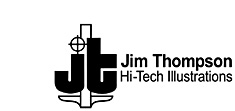About Technical Illustration
By Jim Thompson
The familiar style of airbrushed, smooth-shaded surfaces usually associated with subjects of a mechanical nature, has long dominated the industrial publication and advertising markets. Since the days of laborious methods to produce these exquisite expressions of the industrial and mechanical age, there have been a number of evolutionary improvements to achieve the desired results. From retouching photographs of products to draw even more appeal, to painstakingly detailed artistic renderings in any number of traditional mediums, there has arisen an almost unique world of artistic expression in this arena of markets alone.
Today, we are seeing a whole new set of tools and techniques in a time-honored tradition. The old "bottom line" was making sure clients got what they were looking for and what they had a right to expect from the artist. That "bottom line" hasn't changed, except for the tools and methods of the trade to produce them. The complex and highly appealing subjects of today's products also present a whole new challenge. So the pressure is on for today's technical illustrator to work the magic that helps make the market go round.
Interestingly, the industrial advertising market today is a huge and global one. Unlike the smaller domestic markets, this market involves larger, more expensive, more complicated, longer-range "big ticket" items in a broader and more heavily invested sector of the global economy. It contains subjects that are usually associated with governments or large scale civilian infrastructures. Subjects one might encounter include ships, trains, commercial or military aircraft, large buildings, trucks, tractors, civilian and commercial transportation vehicles, communications or media components and services, space technologies and chemical, medical, scientific, environmental, textile, food and farming industries, to name only a few. This also includes much of the supporting markets for them, such as parts, maintenance, specialized support equipment and a host of many other associated areas of various large scale economies. The importance of the technical illustration trade can never be completely assessed, nor the variety of the subject challenges for the artist.
Occasionally the sheer size, complexity and responsibility of some illustration projects may require not just one artistic specialist, but a number of collaborating artists. This is a good reason to have available a variety of links or sources to accommodate these demands. Thus the internet and the computer have not only become vital in sustaining control of and managing these vast projects, but have given rise to new tools and mediums to facilitate the creative demands of advertisers. The typical successful industrial advertising agency for today's Hi-Tech market is, by necessity, a well-oiled machine of marketing savvy and talent. The expansion of the internet and related computer and telecommunications industries have linked much of the world in a vast maze of interrelated sources for managing the needs of this huge pool of ideas and artistic expression.
The power and variety of today's artistic tools are also a fantastic statement of how far the trade has evolved to keep up with the demands. A typical illustration may involve not only impressive and accurate depictions of products to very exacting specifications, but it may also require special styles and ways in which to execute the subject. The subject might require intimate knowledge of its inner workings, giving way to methods of actually being able to "see through" its surface. The artist might use a "cut-away" or "ghost through" method taking care that it suits the particular nature and complexity of the subject. Then there is the detail, colors, light and textures of the subject that may demand refined methods of rendering or execution. It is increasingly popular to produce some subjects as a 3D data base to expand their versatility with use in video or film animations.
The art of technical illustration is very interesting and challenging. Feel free to contact me for a more in depth discussion or look into this fascinating area of art and communications.

